Southwestern Atlantic Ocean Fronts Detected from Satellite-Derived SST and Chlorophyll
Abstract
1. Introduction
2. Materials and Methods
2.1. Multisource Data
2.2. Methodology
3. Results
3.1. Seasonal Mean Distribution of SST and CHL in the Southwestern Atlantic
3.2. Monthly Mean Distribution of the Southern Ocean Front in the Southwestern Atlantic
4. Discussion
4.1. Comparison of the Thermal Front Path and the Ocean Color Front Path
4.2. Effects of Ocean Current Properties on the Seasonal Spatial-Temporal Variation of Front
4.2.1. Comparison of the Seasonal Distribution of SST and CHL in the East China Sea and the Southwestern Atlantic
4.2.2. Comparison of the Seasonal Distribution of the Kuroshio Front and the Southern Ocean Front
5. Conclusions
Author Contributions
Funding
Institutional Review Board Statement
Informed Consent Statement
Data Availability Statement
Acknowledgments
Conflicts of Interest
References
- Castro, B.M.; Miranda, L.B. Physical oceanography of the western Atlantic continental shelf located between 4N and 34S. In Plankton Ecology of the Southwestern Atlantic; Springer: Cham, Switzerland, 1998. [Google Scholar]
- Bianchi, A.A.; Giulivi, C.F.; Piola, A.R. Mixing in the Brazil Malvinas Confluence. Deep Sea Res. Pt I Oceanogr. Res. Pap. 1993, 40, 1345–1358. [Google Scholar] [CrossRef]
- Piola, A.R.; Franco, B.C.; Palma, E.D.; Saraceno, M. Multiple jets in the Malvinas Current. J. Geophys. Res. Ocean. 2013, 118, 2107–2117. [Google Scholar] [CrossRef]
- Peterson, R.G.; Stramma, L. Upper-Level Circulation in the South-Atlantic Ocean. Prog. Oceanogr. 1991, 26, 1–73. [Google Scholar] [CrossRef]
- Stramma, L.; England, M.H. On the water masses and mean circulation of the South Atlantic Ocean. J. Geophys. Res. Ocean. 1999, 104, 20863–20883. [Google Scholar] [CrossRef]
- Deacon, G.J.D.R. The hydrology of the Southern Ocean. Discov. Rep. 1937, 15, 3–122. [Google Scholar]
- Reid, J.L. Antarctic Polar Front Zone. In Antarctic Oceanology I; AGU: Washington, DC, USA, 2013. [Google Scholar]
- Emery, W.J. Antarctic Polar Frontal Zone from Australia to the Drake Passage. J. Phys. Oceanogr. 2010, 7, 811–822. [Google Scholar] [CrossRef][Green Version]
- Rintoul, S.R.; Sokolov, S.; Williams, M.J.M.; Molino, B.P.; Rosenberg, M.; Bindoff, N.L. Antarctic Circumpolar Current transport and barotropic transition at Macquarie Ridge. Geophys. Res. Lett. 2014, 41, 7254–7261. [Google Scholar] [CrossRef]
- Toggweiler, J.R.; Russell, J. Ocean circulation in a warming climate. Nature 2008, 451, 286–288. [Google Scholar] [CrossRef]
- Lopes, R.M.; Marcolin, C.R.; Brandini, F.P. Influence of oceanic fronts on mesozooplankton abundance and grazing during spring in the south-western Atlantic. Mar. Freshw. Res. 2016, 67, 626–635. [Google Scholar] [CrossRef]
- Legeckis, R. A survey of worldwide sea surface temperature fronts detected by environmental satellites. J. Geophys. Res. Ocean. 1979, 83, 4501–4522. [Google Scholar] [CrossRef]
- Belkin, I.M.; Cornillon, P.C.; Sherman, K. Fronts in Large Marine Ecosystems. Prog. Oceanogr. 2009, 81, 223–236. [Google Scholar] [CrossRef]
- Ullman, D.S.; Cornillon, P.C. Satellite-derived sea surface temperature fronts on the continental shelf off the northeast U.S. coast. J. Geophys. Res. Ocean. 1999, 104, 23459–23478. [Google Scholar] [CrossRef]
- Kostianoy, A.G.; Ginzburg, A.I.; Frankignoulle, M.; Delille, B. Fronts in the Southern Indian Ocean as inferred from satellite sea surface temperature data. J. Mar. Syst. 2004, 45, 55–73. [Google Scholar] [CrossRef]
- Moore, J.K.; Abbott, M.R.; Richman, J.G. Location and dynamics of the Antarctic Polar Front from satellite sea surface temperature data. J. Geophys. Res. Ocean. 1999, 104, 3059–3073. [Google Scholar] [CrossRef]
- Freeman, N.M.; Lovenduski, N.S.; Gent, P.R. Temporal variability in the Antarctic Polar Front (2002–2014). J. Geophys. Res. Ocean. 2016, 121, 7263–7276. [Google Scholar] [CrossRef]
- Venables, H.; Moore, C.M. Phytoplankton and light limitation in the Southern Ocean: Learning from high-nutrient, high-chlorophyll areas. J. Geophys. Res. Ocean. 2010, 115, C02015. [Google Scholar] [CrossRef]
- Sokolov, S.; Rintoul, S.R. On the relationship between fronts of the Antarctic Circumpolar Current and surface chlorophyll concentrations in the Southern Ocean. J. Geophys. Res. Ocean. 2007, 112, C07030. [Google Scholar] [CrossRef]
- Thomalla, S.J.; Fauchereau, N.; Swart, S.; Monteiro, P.M.S. Regional scale characteristics of the seasonal cycle of chlorophyll in the Southern Ocean. Biogeosciences 2011, 8, 2849–2866. [Google Scholar] [CrossRef]
- Graham, R.M.; De Boer, A.M.; van Sebille, E.; Kohfeld, K.E.; Schlosser, C. Inferring source regions and supply mechanisms of iron in the Southern Ocean from satellite chlorophyll data. Deep Sea Res. Pt I Oceanogr. Res. Pap. 2015, 104, 9–25. [Google Scholar] [CrossRef]
- Liu, Z.; Hou, Y. Kuroshio Front in the East China Sea from Satellite SST and Remote Sensing Data. IEEE Geosci. Remote Sens. Lett. 2012, 9, 517–520. [Google Scholar] [CrossRef]
- Chapman, C.C.; Lea, M.A.; Meyer, A.; Sallee, J.B.; Hindell, M. Defining Southern Ocean fronts and their influence on biological and physical processes in a changing climate. Nat. Clim. Chang. 2020, 10, 209–219. [Google Scholar] [CrossRef]
- Bard, E.; Rickaby, R.E.M. Migration of the subtropical front as a modulator of glacial climate. Nature 2009, 460, 380–393. [Google Scholar] [CrossRef] [PubMed]
- Wells, P.; Okada, H. Response of nannoplankton to major changes in sea-surface temperature and movements of hydrological fronts over Site DSDP 594 (south Chatham Rise, southeastern New Zealand), during the last 130 kyr. Mar. Micropaleontol. 1997, 32, 341–363. [Google Scholar] [CrossRef]
- Bristow, L.A.; Mohr, W.; Ahmerkamp, S.; Kuypers, M.M.M. Nutrients that limit growth in the ocean. Curr. Biol. 2017, 27, R474–R478. [Google Scholar] [CrossRef] [PubMed]
- Gentemann, C.L.; Meissner, T.; Wentz, F.J. Accuracy of Satellite Sea Surface Temperatures at 7 and 11 GHz. IEEE Trans. Geosci. Remote Sens. 2009, 48, 1009–1018. [Google Scholar] [CrossRef]
- Vazquez-Cuervo, J.; Dewitte, B.; Chin, T.M.; Armstrong, E.M.; Purca, S.; Alburqueque, E. An analysis of SST gradients off the Peruvian Coast: The impact of going to higher resolution. Remote Sens. Environ. 2013, 131, 76–84. [Google Scholar] [CrossRef]
- Maritorena, S.; d’Andon, O.H.F.; Mangin, A.; Siegel, D.A. Merged satellite ocean color data products using a bio-optical model: Characteristics, benefits and issues. Remote Sens. Environ. 2010, 114, 1791–1804. [Google Scholar] [CrossRef]
- Amante, C.; Eakins, B.W. ETOPO1 1 Arc-Minute Global Relief Model: Procedures, Data Sources and Analysis. Open Access Libr. J. 2009, 16, 20–25. [Google Scholar]
- Thompson, A.F. Jet Formation and Evolution in Baroclinic Turbulence with Simple Topography. J. Phys. Oceanogr. 2009, 40, 257–278. [Google Scholar] [CrossRef][Green Version]
- Sokolov, S.; Rintoul, S.R. Multiple Jets of the Antarctic Circumpolar Current South of Australia. J. Phys. Oceanogr. 2007, 37, 1394–1412. [Google Scholar] [CrossRef]
- Volkov, D.L.; Zlotnicki, V. Performance of GOCE and GRACE-derived mean dynamic topographies in resolving Antarctic Circumpolar Current fronts. Ocean Dyn. 2012, 62, 893–905. [Google Scholar] [CrossRef]
- Graham, R.M.; de Boer, A.M.; Heywood, K.J.; Chapman, M.R.; Stevens, D.P. Southern Ocean fronts: Controlled by wind or topography? J. Geophys. Res. Ocean. 2012, 117, C08018. [Google Scholar] [CrossRef]
- Campbell, J.W. The lognormal distribution as a model for bio-optical variability in the sea. J. Geophys. Res. Ocean. 1995, 100, 13237–13254. [Google Scholar] [CrossRef]
- Canny, J.; Intelligence, M. A Computational Approach to Edge Detection. IEEE Trans. Pattern Anal. Mach. Intell. 1986, 6, 679–698. [Google Scholar] [CrossRef]
- Wang, Y.; Yu, Y.; Zhang, Y.; Zhang, H.R.; Chai, F. Distribution and variability of sea surface temperature fronts in the south China sea. Estuar. Coast. Shelf Sci. 2020, 240, 106793. [Google Scholar] [CrossRef]
- Wong, G.; Chao, S.Y.; Li, Y.H.; Shiah, F.K. The Kuroshio edge exchange processes (KEEP) study—An introduction to hypotheses and highlights. Cont. Shelf Res. 2000, 20, 335–347. [Google Scholar] [CrossRef]
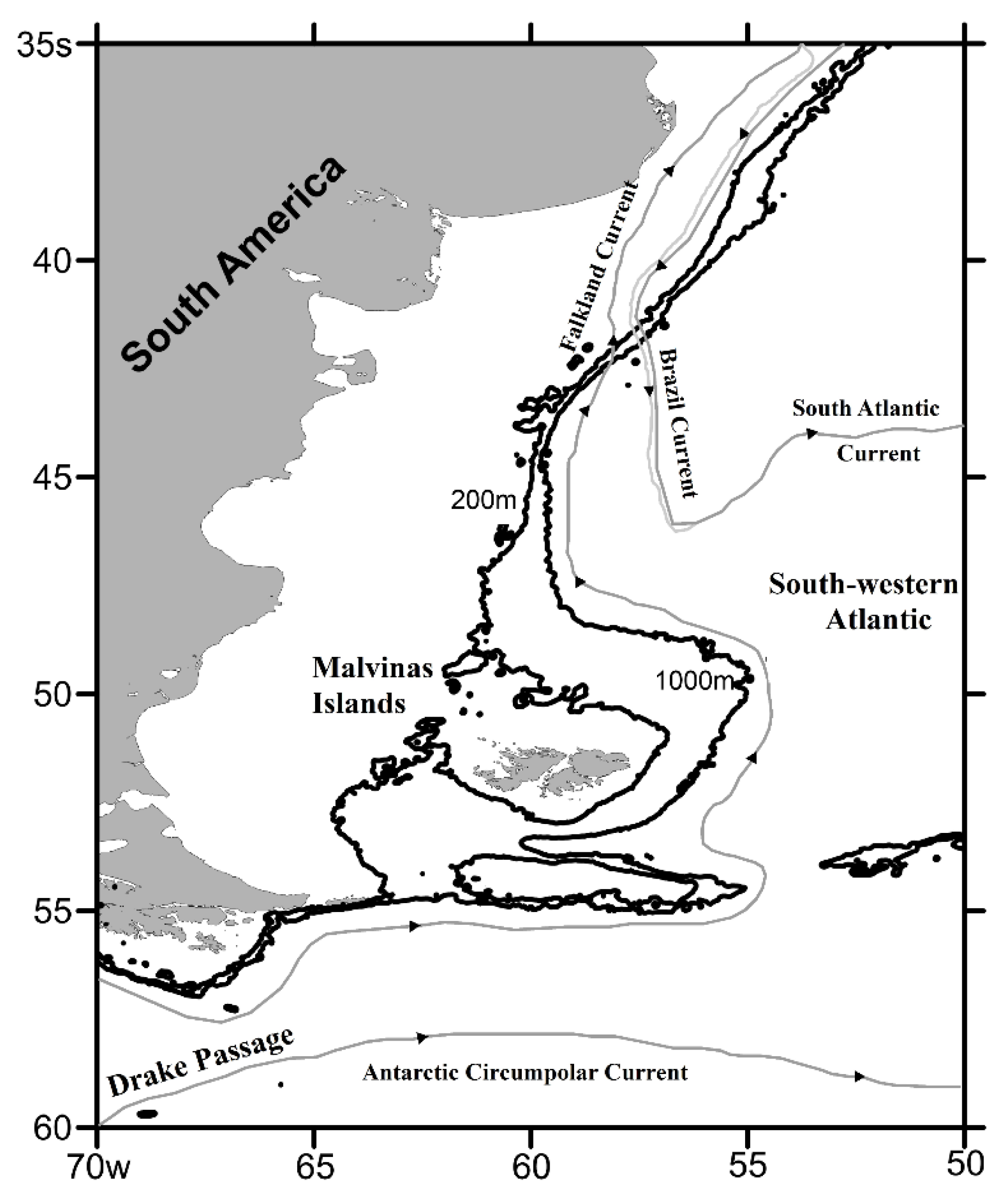


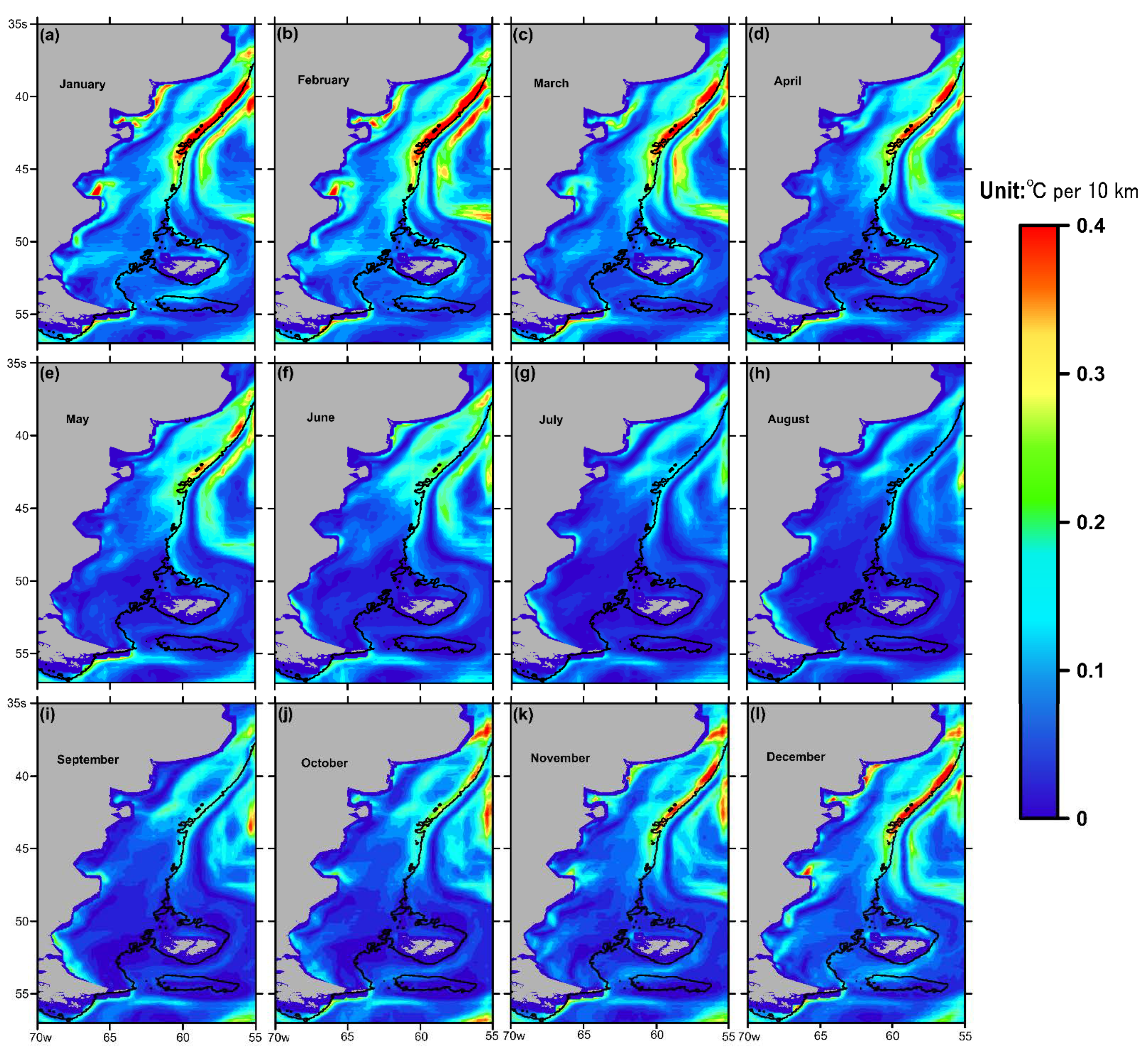

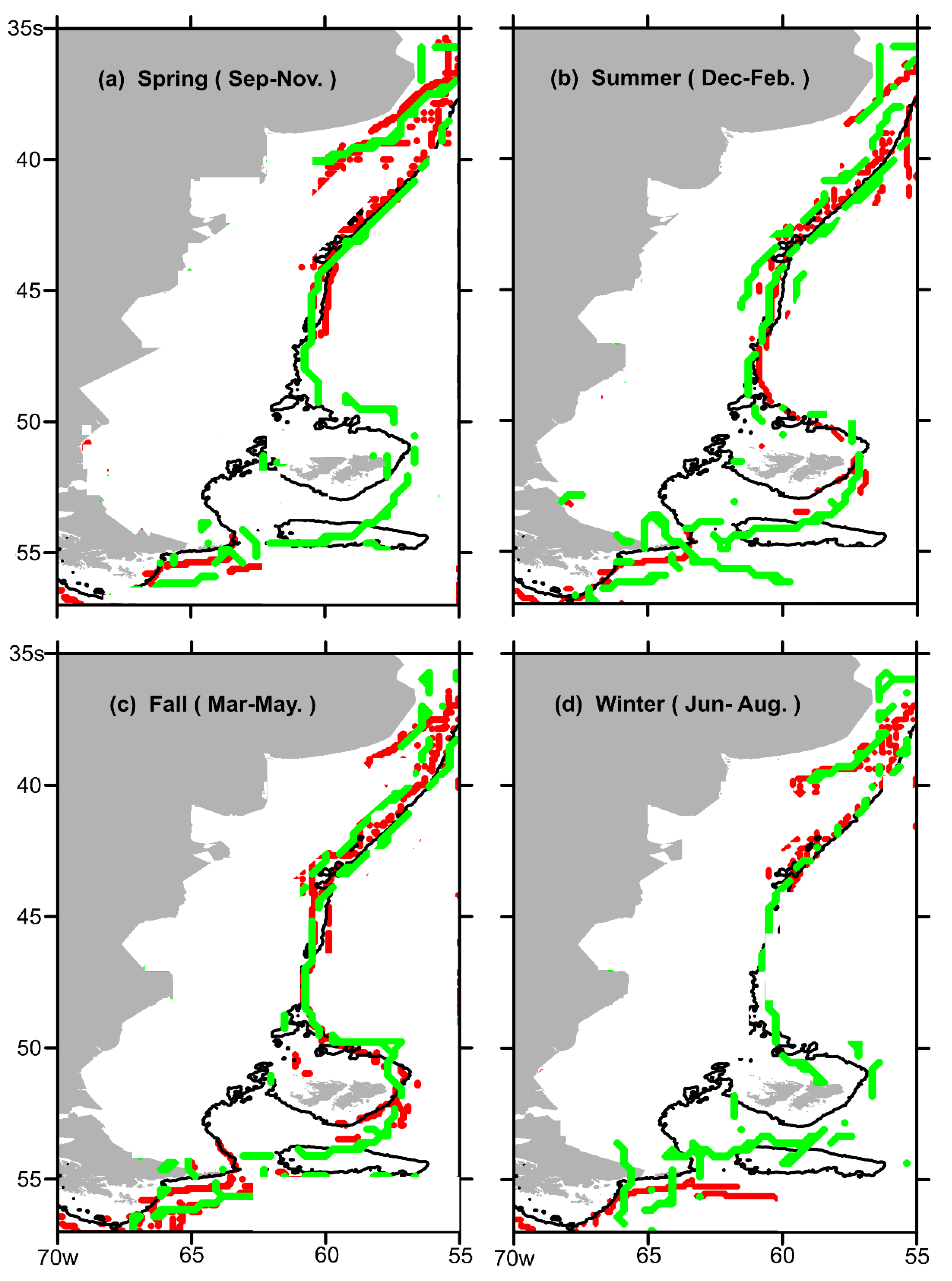
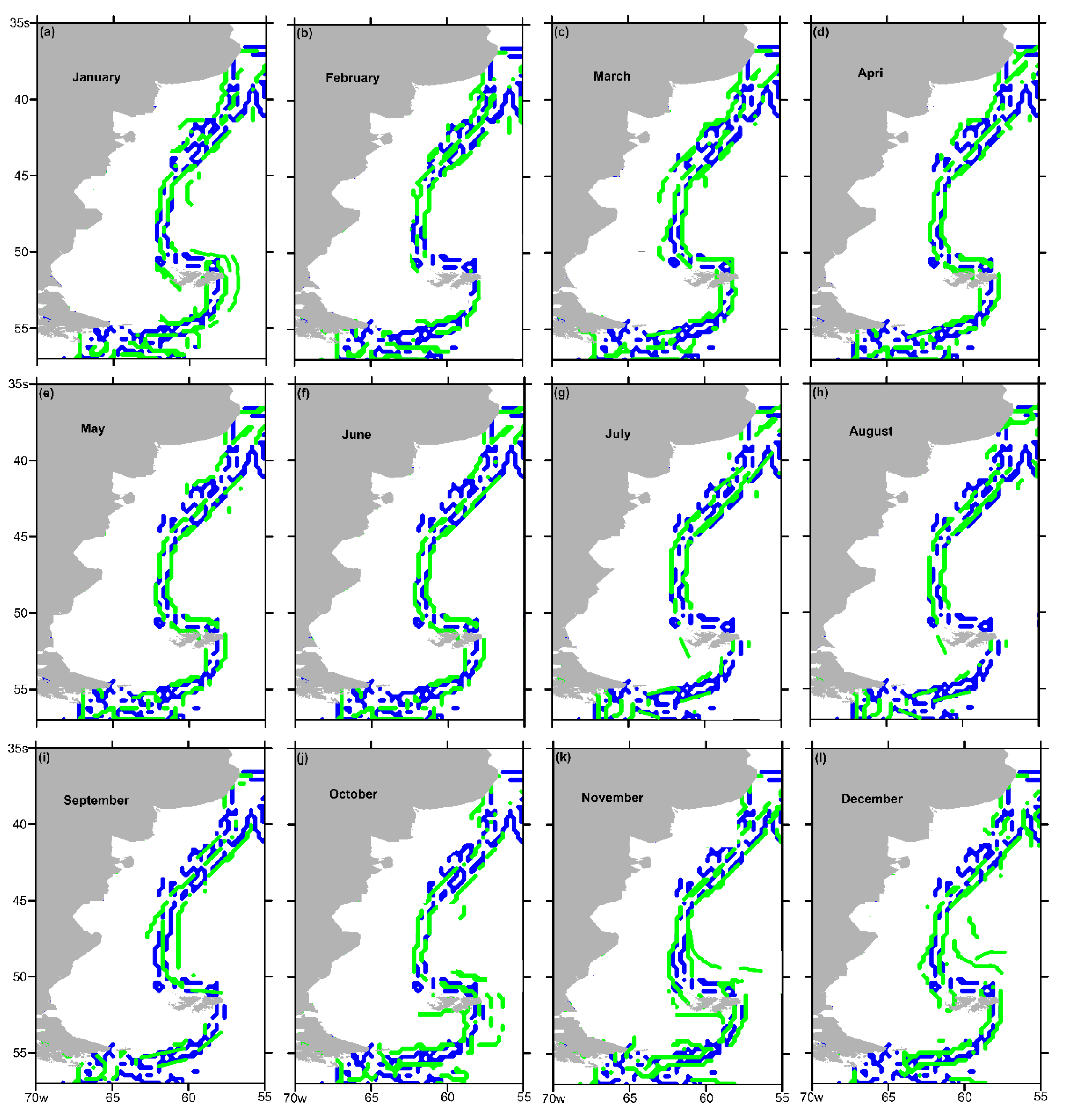

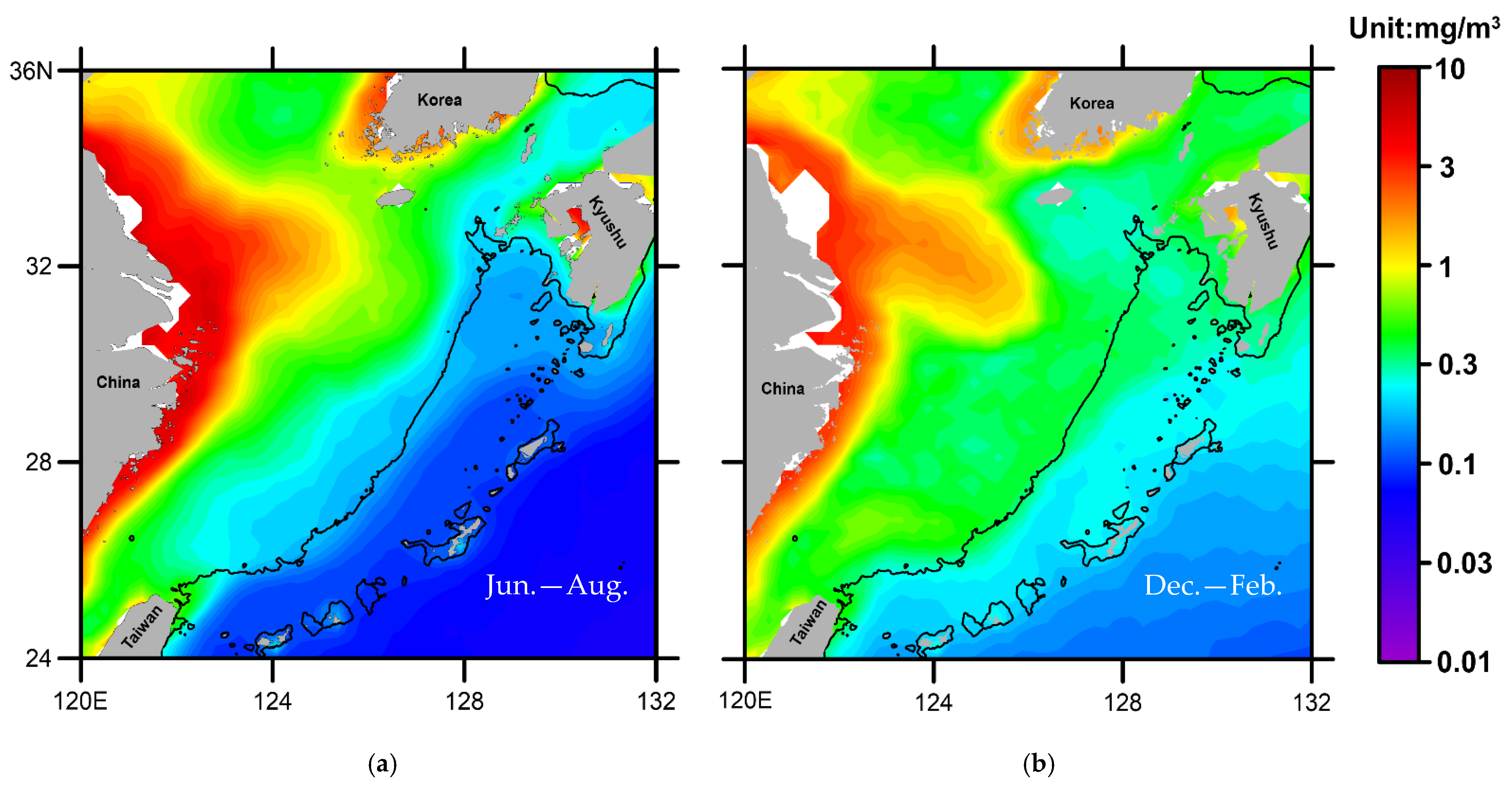
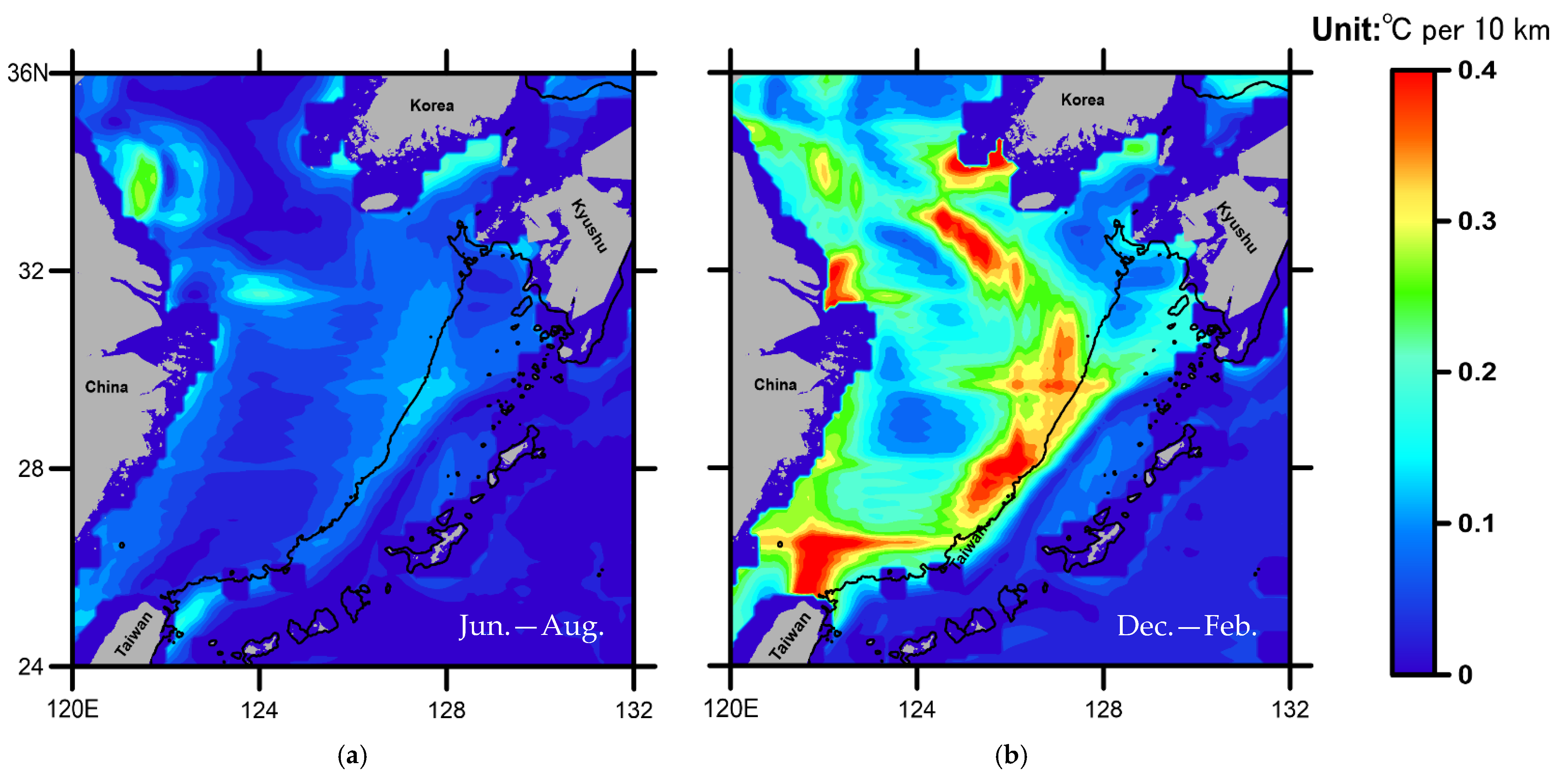
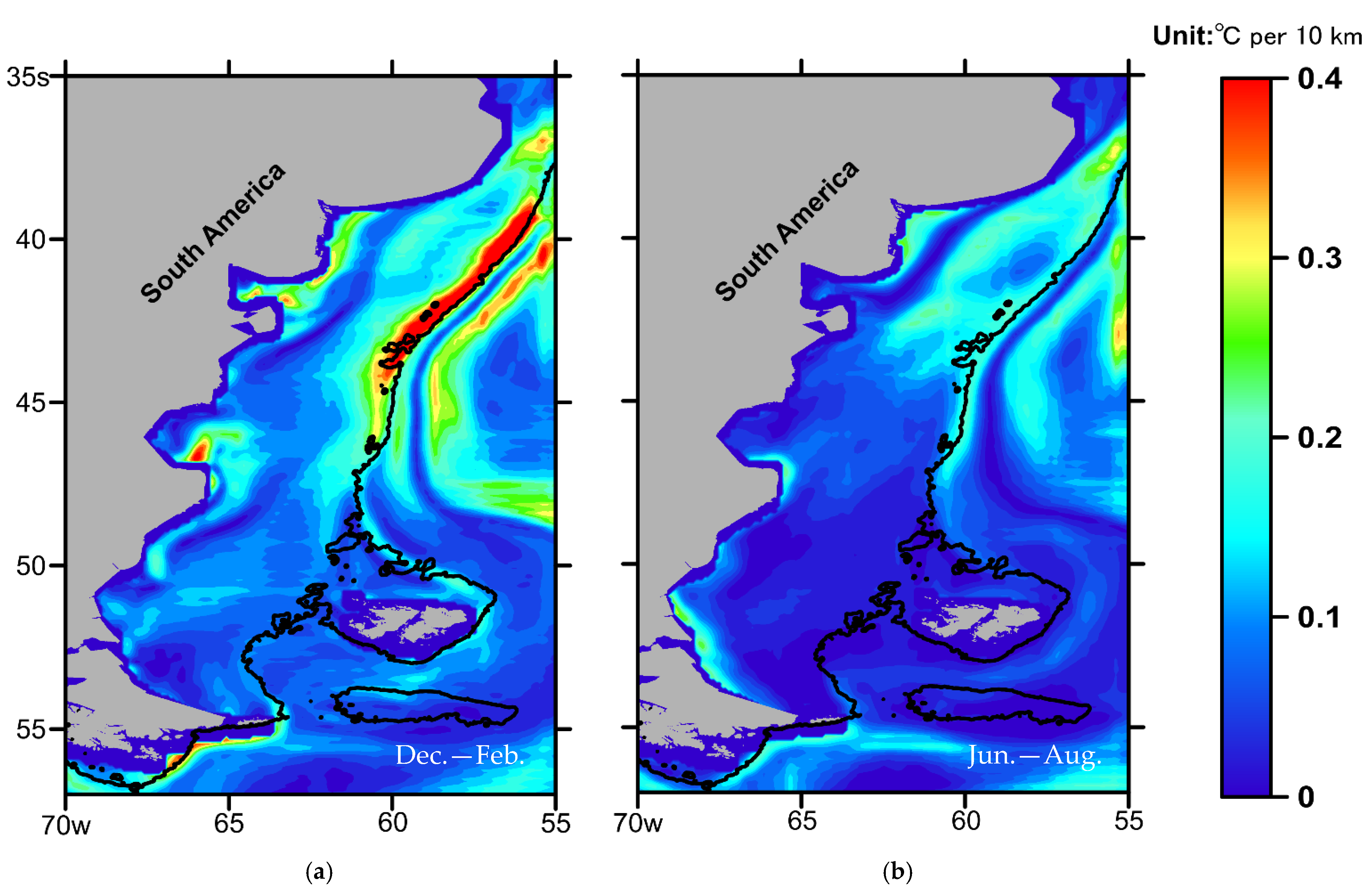

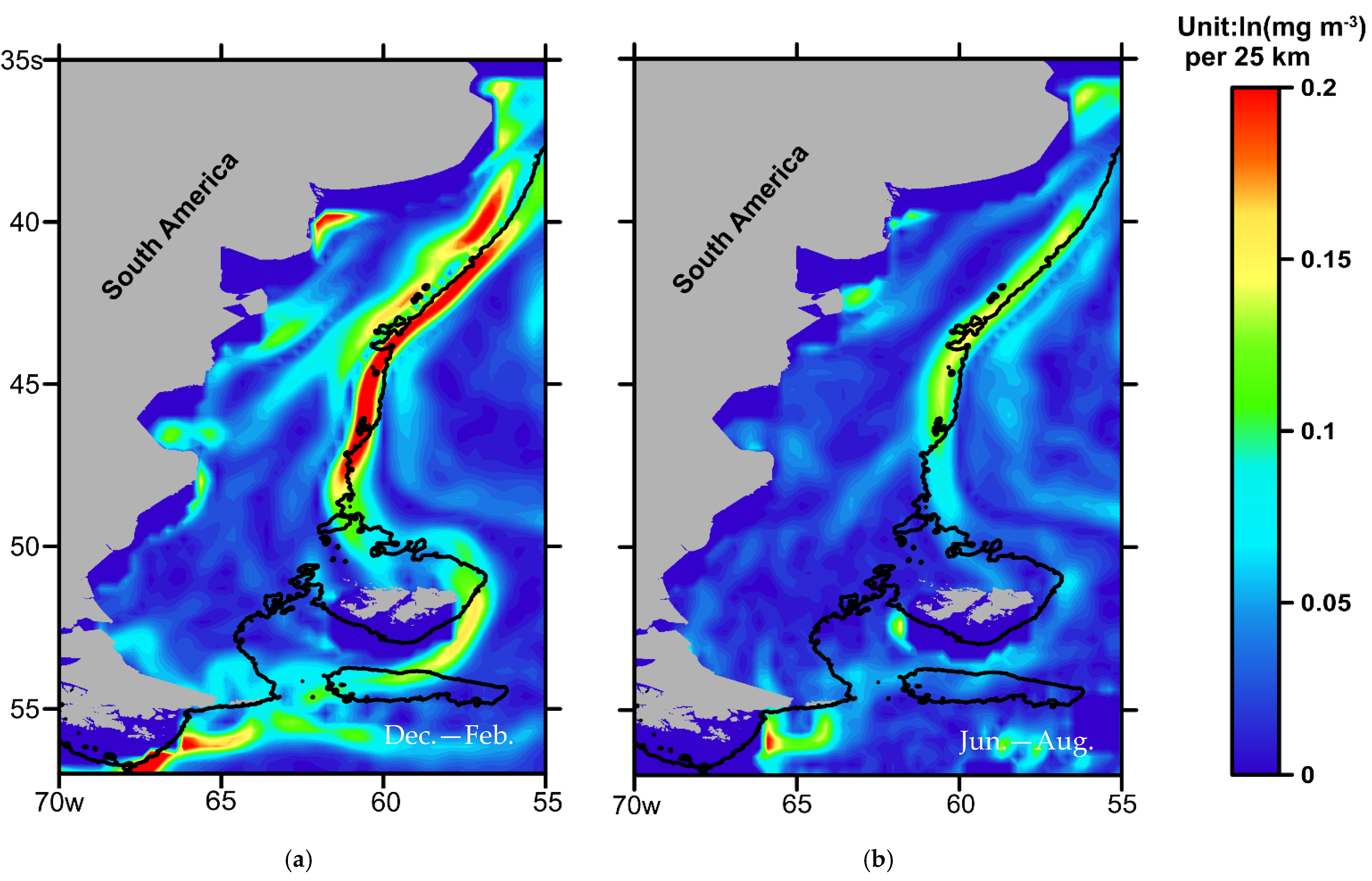
| Season | Fall | Winter | Spring | Summer | ||||||||
|---|---|---|---|---|---|---|---|---|---|---|---|---|
| Month | Mar. | Apr. | May. | Jun. | Jul. | Aug. | Sep. | Oct. | Nov. | Dec. | Jan. | Feb. |
| Difference Rate (%) | 5.87% | 5.48% | 5.84% | 5.92% | 4.75% | 4.98% | 5.16% | 5.74% | 6.15% | 7.37% | 7.03% | 5.96% |
Publisher’s Note: MDPI stays neutral with regard to jurisdictional claims in published maps and institutional affiliations. |
© 2021 by the authors. Licensee MDPI, Basel, Switzerland. This article is an open access article distributed under the terms and conditions of the Creative Commons Attribution (CC BY) license (https://creativecommons.org/licenses/by/4.0/).
Share and Cite
Wang, Z.; Chen, G.; Han, Y.; Ma, C.; Lv, M. Southwestern Atlantic Ocean Fronts Detected from Satellite-Derived SST and Chlorophyll. Remote Sens. 2021, 13, 4402. https://doi.org/10.3390/rs13214402
Wang Z, Chen G, Han Y, Ma C, Lv M. Southwestern Atlantic Ocean Fronts Detected from Satellite-Derived SST and Chlorophyll. Remote Sensing. 2021; 13(21):4402. https://doi.org/10.3390/rs13214402
Chicago/Turabian StyleWang, Zhi, Ge Chen, Yong Han, Chunyong Ma, and Ming Lv. 2021. "Southwestern Atlantic Ocean Fronts Detected from Satellite-Derived SST and Chlorophyll" Remote Sensing 13, no. 21: 4402. https://doi.org/10.3390/rs13214402
APA StyleWang, Z., Chen, G., Han, Y., Ma, C., & Lv, M. (2021). Southwestern Atlantic Ocean Fronts Detected from Satellite-Derived SST and Chlorophyll. Remote Sensing, 13(21), 4402. https://doi.org/10.3390/rs13214402






